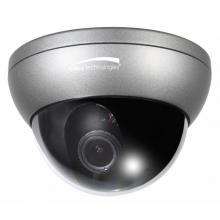 The Truth About Security Camera Options
The Truth About Security Camera Options
We get a lot of calls from people want to install home video camera systems. And for good reason – when used right, video cameras can help deter burglaries and prevent theft.
But there’s a lot of misinformation and misunderstanding surrounding video cameras and their role in home security. And, many times, this leads to unrealistic expectations.
So we want to set the record straight. If you’re looking for a home video surveillance system, we want to show you what matters and what doesn’t. But first, let’s take a look at some of the most common misconceptions of home video surveillance systems.
Cameras won’t do what you see on CSI (at least not in your price range)
Cop TV shows and movies have glorified the humble surveillance camera. It’s not uncommon for a detective to zoom in on a blurry video, stroke the keyboard a few times and magically see a clear picture of a suspect’s face.
And then, later, another video camera might just barely catch the back of a vehicle. Then the police use computer wizardry to turn that into a perfectly legible license plate.
Don’t get us wrong, technology like that exists. But it’s more expensive than you can imagine. (Even major police departments don’t have that kind of technology.)
Wireless doesn’t exactly mean “no wires”
Many people want wireless video surveillance cameras for their home security system because they think it means they won’t have to run any wires.
While there definitely are easy-to-install wireless video cameras, there is still a wire you need to account for—the power cable. It wouldn’t make sense for a video camera to be running off a battery (they’d have to be replaced almost daily). So even wireless video cameras need to be plugged in to a power outlet somehow.
The “wireless” part means they transmit their video signal wirelessly.
Watch out for cheap, bundled video solutions
These days you can buy video surveillance cameras just about anywhere. But they often work using proprietary technology (translation: they won’t work with your existing security system) and the quality is not as high.
There are serious issues to consider with hidden cameras
Hidden cameras, sometimes called spy cameras or covert cameras, are video cameras that are designed to look like something else (a smoke detector, for example).
We don’t sell these types of cameras and strongly advise against installing them because of the legal issues involved.
In addition, one of the main goals of video cameras is to deter theft/burglaries. Because people don’t want to be caught “in the act”, the visible presence of cameras can deter crime. However, if your cameras are hidden, they lose that benefit.
What you should pay attention to
Now that you know a few more things about home security cameras, here are a few things that you should pay attention to when shopping for a home video security system.
Live view vs. recorded video
Do you want to view live video of your home or just view recordings later? Get IP cameras, like those we offer with Alarm.com, to view live video. Consider a system with a digital video recorder (DVR) if you want to view recordings.
 Type of camera
Type of camera
Don’t use a cheap webcam from a retail store. Those are typically designed for close-up situations (like video chatting) and don’t work well for longer-range applications like home security. The two types of home security cameras we recommend are dome cameras and bullet cameras.
Image type (color, black and white, infrared, etc.)
Depending on where you want to place your video cameras, you may want to consider the image type of the camera you’re purchasing. Most cameras we sell record in color during the day and then switch to one of three modes at night. They are:
- Black & white – Vidoe cameras switch to black and white mode at night. This allows them to produce a clearer picture in less light.
- Intensifier – Other cameras have an intensifier mode for night. This means they increase the ambient light (environmental light) levels so you can see more. Of course, this means if there is no ambient light at all, there will be no image.
- Infrared (IR) – Infrared cameras work even in low-light settings. These cameras send out infrared signals and record what is bounced back. Since IR is invisible to humans, the cameras can record what’s happening even in what seems like pitch black to the naked eye.
Image quality (TVL of resolution)
The quality of the image a video camera captures is measured in TV lines (TVL). The higher the TVL number the better resolution quality the camera has. The typical home surveillance camera is between 400 and 700 TVL. High-resolution cameras can go up to 900TVL, but you probably won’t need that high quality in your home.
Coverage (range of view)
One of the most important parts of a video surveillance camera is it’s range of view. This tells you what will be in the view of the camera and how wide of a viewing angle it will record.
Video monitoring
One of the benefits of adding video surveillance to your home is the ability to cut down on false alarms and to get faster response from authorities when an issue arises. However, both of these benefits require your surveillance and security system to be monitored by a trusted security company.
Get a professional consultation
Every home is different and every family’s needs are different. That’s why you should have a professional security consultant take a look at your home and listen to your security goals so they can help you design a video surveillance system that works best for you and your home.

